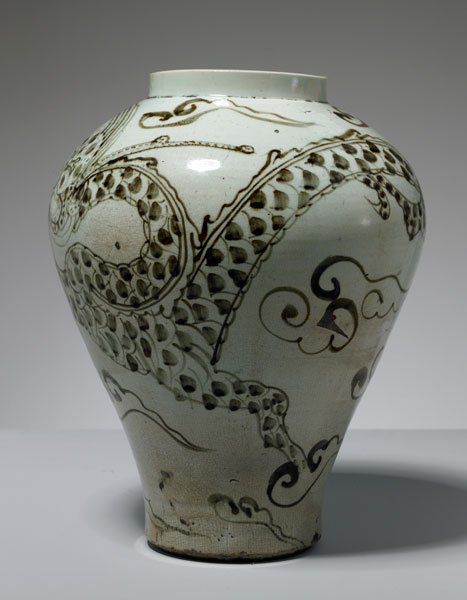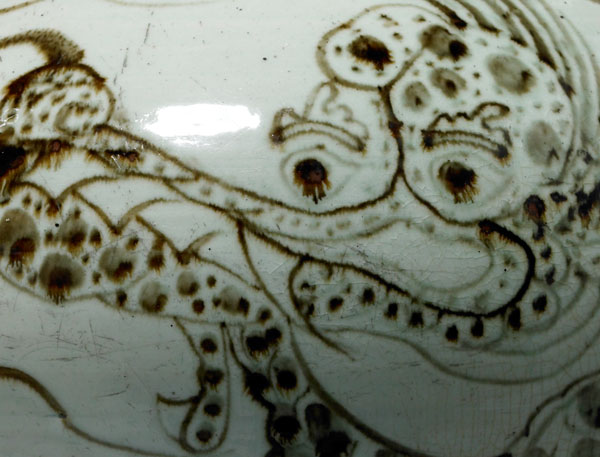Korean Dragon Jar

Dragon Jar, 18th century
Porcelain with underglaze iron decor
Gift of Louis W. Hill, Jr.
Introduction
Sweeping through the sky, this playful dragon bends its curving serpent body up and down and back and forth around the jar on which it is whimsically painted.
Korea has long been influenced by China, its large and powerful neighbor to the west. Yet this small peninsular country has kept its own artistic character. Follow the dragon to find out what makes this ceramic vessel uniquely Korean.
<
KEY IDEA ONE
Adopted and Adapted
Since the late Stone Age, potters have brought clay and fire together to make vessels for preparing and storing food and for use in ceremonies. In Asia, people in neighboring regions admired each other’s ceramic wares and learned from them. They adopted foreign technologies and techniques and then adapted them to their own work in clay.
Throughout the ages, Chinese art greatly influenced Korean ceramics, and Koreans, in turn, shared their knowledge and skill with the Japanese. Many developments in clays, glazes, and firing techniques reached Korea through trade with China. The spread of religions and philosophies also had an effect on art.
Although Chinese influence was so strong, Koreans always had a firm sense of their own identity, and they created ceramics, like this dragon jar, that are uniquely Korean.

Celadon wares, with their beautiful blue-green glazes, originated in China but brought fame to Korea during the Koryo dynasty (918-1392). The Chinese admired and collected Korean celadons.
Korea, Koryo dynasty, Double Gourd-Shaped Ewer, 12th century, glazed porcelaneous stoneware, Minneapolis Institute of Art, The Ethel Morrison Van Derlip Fund and The Ellen and Fred Wells Fund.

Blue and white glazes were popular in Ming-dynasty China. In Korea, this glazing technique was adopted by potters of the Choson dynasty.
China, Imperial Dragon Vase, 1426-35, porcelain with cobalt blue decor under a clear glaze, Minneapolis Institute of Art, Gift of Ruth and Bruce Dayton.

Compare this Korean blue-and-white dragon jar to the blue-and-white Chinese jar.
Korea, Choson dynasty, Dragon Jar, 18th century, porcelain with underglaze cobalt design, Minneapolis Institute of Art, The William Hood Dunwoody Fund.
KEY IDEA TWO
Chosen for the Choson
During the Choson dynasty (1392-1910), Korean rulers made Confucianism the official religion. Confucianism stresses living a simple and humble life, and Korean ceramics were influenced by this ideal. Their shape and decoration became simpler. Many early Choson wares were left undecorated except for a coat of white glaze.
The type of clay used by Korean potters changed, too. The dragon jar is made of porcelain. Created from a clay called kaolin, porcelain is white or grayish and very hard. The Chinese were the first to discover how to make it. Both the Chinese and the Koreans felt that porcelain objects complemented the Confucian virtues of humility and simplicity.
As time passed, Confucianism became less strict, and potters began to add simple designs in blue, brown, or red. The dragon jar’s brown decoration was painted with iron oxide. Unlike the precise detailing on Chinese porcelains, this Korean design is carefree and whimsical. For example, the dragon’s scales are just large dabs of color. (Imagine a paint-filled brush pouncing across the jar, guided by the artist’s hand.) Such playful brushwork also appears in the dragon’s whiskers and the clouds. This kind of painting may look easy, but ceramic artists needed great skill to decorate porcelain. A quick-moving hand was important because porcelain absorbed the paint fast.

Many Choson ceramics were simple and undecorated white wares, in keeping with Confucian ideals.
Korea, Choson dynasty, Maebyong Jar, 18th century, white porcelain with celadon glaze, Minneapolis Institute of Art, The Ethel Morrison Van Derlip Fund and the Ellen and Fred Wells Fund.

Blue-and-white Choson ceramics were made only for aristocrats. The blue color came from imported cobalt, which was very expensive.
Korea, Choson dynasty, Dragon Jar, 18th century, porcelain with underglaze cobalt design, Minneapolis Institute of Art, The William Hood Dunwoody Fund.

The liveliness of this bottle’s painted design is typical of ceramic decoration in the Choson dynasty.
Korea, Choson dynasty, Rice Bale Bottle, 15th century, glazed stoneware with painted slip decoration, Minneapolis Institute of Art, Gift of funds from Fred and Ellen Wells.
KEY IDEA THREE
A Delightful Dragon.
Symbols of good fortune and power, dragons were a favorite decoration on Korean ceramics. Though inspired by Chinese designs, Korean dragons are much more playful. The one on this jar was whimsically painted with brushstrokes that make it appear lighthearted and humorous. At the same time, the artist showed the dragon’s power, giving it a long snout, sharp teeth, fierce eyes, and hair standing on end.
In decorating dragon jars, artists painted the creature so that its body covered the whole jar. The dragon wrapping itself around this jar is shown swooshing through the sky, surrounded by wispy clouds. Dragons were said to control the weather and bring rain, a good omen for a plentiful harvest.
Originally, dragon jars were reserved for ceremonies and for decoration in royal households. But eventually they came into wider use. Often the number of claws on a dragon’s feet reveals something about the person the jar was made for. Five-clawed dragons, which represented the emperor, were for royalty only. Since this dragon’s feet are concealed by its snout and a cloud, the jar likely belonged to a common household.

In this view of the jar, the dragon twists and turns, curving itself over the jar’s round body.

This is the other side of the dragon jar.

A few simple brushstrokes suggest sharp teeth.
Related Activities
Korean Art at Mia
Use the search feature of Mia’s website to see more Korean ceramics and other artworks in the collection. Even better, visit the museum to explore the Korean art galleries. To come as a school group, use our easy online request form.
Symbols of Power and Luck
To Koreans, dragons symbolize power and good fortune. What creatures do people in other parts of the world associate with these desires? Make a list and draw a picture of your favorite. Include details and features that connect that creature with power and luck.
World Ceramics
Learn about ceramics around the world through the Minneapolis Institute of Art online resource World Ceramics.
Suggested Reading
Carpenter, Frances. Tales of a Korean Grandmother: 32 Traditional Tales from Korea. 1947. North Clarendon, Vt.: Tuttle Publishing, 1989.
Carus, Marianne. Fire and Wings: Dragon Tales from the East and West. Chicago: Cricket Books, 2002.
Han, Heung-Gi. Let’s Visit Korea. Elizabeth, N.J.: Hollym International Corporation, 2006.
Hill, Valerie. Korea. Ask about Asia series. Broomall, Pa.: Mason Crest Publishers, 2002.
McClure, Gillian. The Land of the Dragon King and Other Korean Stories. London: Frances Lincoln, 2008.
